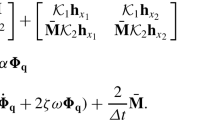Abstract
An automatic filtering algorithm is proposed for the accurate estimation of the second derivatives of kinematic signals with impacts. The impacts considered here occur when a moving object hits a rigid surface. The algorithm performs time-frequency filtering in the Wigner representation, to deal efficiently with the non-stationarities caused by such impacts, and adjusts the parameters of its time-frequency filtering function so that the filtering process adapts to the individual characteristics of the signal in hand. Performance analysis and comparative evaluation with experimentally acquired kinematic impact signals demonstrated a higher accuracy, with performance advantages over two widely used conventional automatic methods: linear phase autoregressive model-based derivative assessment (LAMBDA) and generalised cross-validation using quintic splines (GCVQS). For high impacts, the average absolute relative error in estimating the peak acceleration was 5.7% with the proposed method, 17.2% with a Butterworth low-pass filter optimised to yield minimum overall acceleration RMS error (best-case result), 18.3% with the LAMBDA method, and 37.2% with the GCVQS method. For signals with low impacts, the average absolute relative error was 19.4%, 6.9%, 8.3% and 19.1%, respectively, in each case, which indicates that, for signals with a low-frequency content, there is no need for such time-frequency filtering.
Similar content being viewed by others
References
Boashash, B. (1992): ‘Estimating and interpreting the instantaneous frequency: Part 1: algorithms and applications’,Proc. IEEE,80, pp. 539–568
Claasen, T. A. C. M., andMecklenbrauker, W. F. G. (1980): ‘The Wigner distribution: a tool for time-frequency signal analysis (Part I, Part II)’,Philips J. Res.,35, pp. 217–250, 276–300
Cohen, L. (1989): ‘Time-frequency distributions—a review’,Proc. IEEE,77, pp. 941–981
Damico, M., andFerrigno, G. (1990): ‘Technique for the evaluation of derivatives from noisy biomechanical displacement data using a model-based-bandwidth-selection procedure’,Med. Biol. Eng. Comput.,28, pp. 407–415
Damico, M., andFerrigno, G. (1992): ‘Comparison between the more recent techniques for smoothing and derivative assessment in biomechanics’,Med. Biol. Eng. Comput.,30, pp. 193–204
Dowling, J. (1985): ‘A modelling strategy for the smoothing of biomechanical data’ inJohnsson, B. (Ed.): ‘Human kinetics’ (Biomechanics XB, Champaign, IL, 1985), pp. 1163–1167
Giakas, G., andBaltzopoulos, V. (1997a): ‘Optimal digital filtering requires a different cutoff frequency strategy for the determination of the higher derivatives’,J. Biomech.,30, pp. 851–855
Giakas, G., andBaltzopoulos, V. (1997b): ‘A comparison of automatic filtering techniques applied to biomechanical walking data’,J. Biomech.,30, pp. 847–850
Giakas, G., Baltzopoulos, V., andBartlett, R. M. (1998): ‘Improved extrapolation techniques in recursive digital filtering: a comparison between least-squares and linear prediction’,J. Biomech.,31, pp. 87–91
Giakas, G., Stergioulas, L. K., andVourdas, A. (2000): ‘Time-frequency analysis and filtering of kinematic signals with impacts using the Wigner function: accurate estimation of the second derivative’,J. Biomech.,33, pp. 567–574
Wachowiak, M. P., Rash, G. S., Quesada, P. M., andDesoky, A. H. (2000): ‘Wavelet-based noise removal for biomechanical signals: A comparative study’,IEEE Trans. Biomed. Eng.,47, pp. 360–368
Winter, D. A. (1990): ‘Biomechanics and motor control of human movement’ (Wiley, New York, 1990)
Woltring, H. J. (1986): ‘A Fortran package for generalised, cross-validatory spline smoothing and differentiation’,Adv. Eng. Softw.,8, pp. 104–107
Author information
Authors and Affiliations
Corresponding author
Rights and permissions
About this article
Cite this article
Georgakis, A., Stergioulas, L.K. & Giakas, G. Automatic algorithm for filtering kinematic signals with impacts in the Wigner representation. Med. Biol. Eng. Comput. 40, 625–633 (2002). https://doi.org/10.1007/BF02345300
Received:
Accepted:
Issue Date:
DOI: https://doi.org/10.1007/BF02345300




